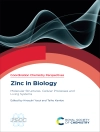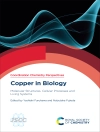About the Series…
Metal Ions in Life Sciences links coordination
chemistry and biochemistry in their widest sense and thus increases
our understanding of the relationship between the chemistry of
metals and life processes. The series reflects the
interdisciplinary nature of Biological Inorganic Chemistry
and coordinates the efforts of scientists in fields like
biochemistry, inorganic chemistry, coordination chemistry,
molecular and structural biology, enzymology, environmental
chemistry, physiology, toxicology, biophysics, pharmacy, and
medicine. Consequently, the volumes are an essential source for
researchers active in these and related fields as well as teachers
preparing courses, e.g., in Bioinorganic Chemistry.
About this Book…
Volume 1, devoted solely to the vital research area
concerning the role of metal ions in neurodegenerative diseases,
offers in 15 stimulating chapters an authoritative and timely view
of this fascinating subject.
Written by 41 internationally recognized experts,
Neurodegenerative Diseases and Metal Ions highlights,
supported by 130 illustrations, the recent progress made in
understanding the role metal ions play in diseases like
transmissible spongiform encephalopathies (Creutzfeldt-Jakob and
related diseases), Alzheimer’s, Parkinson’s, Huntington’s, Wilson’s
and Menkes’ diseases, as well as in familial amyotrophic lateral
sclerosis and others. The interplay between metal ions,
catecholamines and the formation of reactive oxygen species
resulting in oxidative stress is considered, as is the
metalloneurochemistry of zinc and the neurotoxicity of aluminum,
cadmium, lead, and mercury. The need for novel drugs which
manipulate metal-centered neuropathology is emphasized.
İçerik tablosu
HISTORICAL DEVELOPMENT AND PERSPECTIVES OF THE SERIES.
PREFACE TO VOLUME 1.
CONTRIBUTORS TO VOLUME 1.
TITLES OF VOLUMES 1-44 IN THE METAL IONS IN BIOLOGICAL
SYSTEMS SERIES.
CONTENTS OF VOLUMES IN THE METAL IONS IN LIFE SCIENCES
SERIES.
1 THE ROLE OF METAL IONS IN NEUROLOGY. AN
INTRODUCTION (Dorothea Strozyk and Ashley I. Bush).
2 PROTEIN FOLDING, MISFOLDING, AND DISEASE
(Jennifer C. Lee, Judy E. Kim, Ekaterina V. Pletneva, Jasmin
Faraone-Mennella, Harry B. Gray, and Jay R. Winkler).
3 METAL ION BINDING PROPERTIES OF PROTEINS RELATED TO
NEURODEGENERATION (Henryk Kozlowski, Marek Luczkowski,
Daniela Valensin, and Gianni Valensin).
4 METALLIC PRIONS: MINING THE CORE OF TRANSMISSIBLE
SPONGIFORM ENCEPHALOPATHIES (David R. Brown).
5 THE ROLE OF METAL IONS IN THE AMYLOID PRECURSOR
PROTEIN AND IN ALZHEIMER’S DISEASE (Thomas A. Bayer
and Gerd Multhaup).
6 THE ROLE OF IRON IN THE PATHOGENESIS OF
PARKINSON’S DISEASE (Manfred Gerlach, Kay L. Double,
Mario E. Götz, Moussa B. H. Youdim, and Peter
Riederer).
7 IN VIVO ASSESSMENT OF IRON IN
HUNTINGTON’S DISEASE AND OTHER AGE-RELATED NEURODEGENERATIVE
BRAIN DISEASES (George Bartzokis, Po H. Lu, Todd A. Tishler,
and Susan Perlman).
8 COPPER-ZINC SUPEROXIDE DISMUTASE AND FAMILIAL
AMYOTROPHIC LATERAL SCLEROSIS (Lisa J. Whitson and P. John
Hart).
9 THE MALFUNCTIONING OF COPPER TRANSPORT IN WILSON AND
MENKES DISEASES (Bibudhendra Sarkar).
10 IRON AND ITS ROLE IN NEURODEGENERATIVE DISEASES
(Roberta J. Ward and Robert R. Crichton).
11 THE CHEMICAL INTERPLAY BETWEEN CATECHOLAMINES AND
METAL IONS IN NEUROLOGICAL DISEASES (Wolfgang Linert, Guy N.
L. Jameson, Reginald F. Jameson, and Kurt A. Jellinger).
12 ZINC METALLONEUROCHEMISTRY: PHYSIOLOGY, PATHOLOGY,
AND PROBES (Christopher J. Chang and Stephen J.
Lippard).
13 THE ROLE OF ALUMINUM IN NEUROTOXIC AND
NEURODEGENERATIVE PROCESSES (Tamás Kiss, Krisztina
Gajda-Schrantz, and Paolo F. Zatta).
14 NEUROTOXICITY OF CADMIUM, LEAD, AND MERCURY
(Hana R. Pohl, Henry G. Abadin, and John F. Risher).
15 NEURODEGENERATIVE DISEASES AND METAL IONS. A
CONCLUDING OVERVIEW (Dorothea Strozyk and Ashley I.
Bush).
SUBJECT INDEX.
Yazar hakkında
Astrid Sigel has studied languages and was an editor of the
Metal Ions in Biological Systems series (until Volume 44)
and also of the Handbooks on Toxicity of Inorganic Compounds
(1988), on Metals in Clinical and Analytical
Chemistry (1994; both with H. G. Seiler), and on
Metalloproteins (2001; with Ivano Bertini) (Dekker, New York).
Helmut Sigel is Emeritus Professor (2003) of
Inorganic Chemistry at the University of Basel, Switzerland, and a
previous editor of the MIBS series until Volume 44. He
serves on various editorial and advisory boards, published over 300
articles on metal ion complexes of nucleotides, coenzymes, and
other biologically relevant ligands. He lectured worldwide and was
named Protagonist in Chemistry (2002) by ICA (issue
339). Among further honors are the P. Ray Award
(Indian Chemical Society, of which he is also an Honorary Fellow),
the Werner Award (Swiss Chemical Society), a
Doctor of Science honoris causa degree (Kalyani University,
India), appointments as Visiting Professor (e.g., Austria,
China, UK) and Endowed Lectureships.
Roland K. O. Sigel is Assistant Professor (2003) of
Inorganic Chemistry at the University of Zürich, Switzerland,
endowed with a Förderungsprofessur of the Swiss
National Science Foundation. He received his doctoral degree
summa cum laude (1999) from the University of Dortmund,
Germany, working with Bernhard Lippert; thereafter he spent nearly
three years at Columbia University, New York, USA, in the group of
Anna Marie Pyle (now Yale University); during the six years abroad
he received several fellowships from various sources. His research
focuses on the structural and catalytic role of metal ions in
ribozymes, especially group II introns, and on related topics. He
was also an editor of Volumes 43 and 44 of the MIBS
series.












